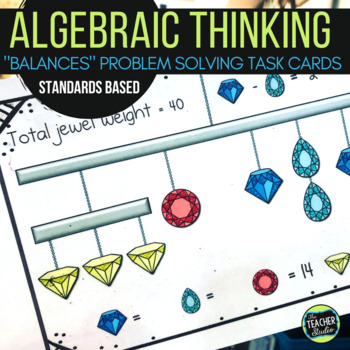Balancing Equations Problem Solving Task Cards - Math Challenge Activity
- PDF
- Google Apps™

What educators are saying
Description
Understanding the concept of “equal” is a critical part of developing number sense and algebraic thinking. This resource helps students get more flexible “playing” with numbers as they try to use algebra thinking to “balance” the gems on the two sides of the balance.
These cards help students develop their math reasoning AND computation skills while having a fun and engaging task! My students LOVE these--and feel like real mathematicians when they figure them out!
NOW AVAILABLE WITH DIGITAL AND PRINT OPTIONS INCLUDED!
The first group of cards works to build understanding—and then they get increasingly more open-ended for students to “build” their own problems and show their understanding. I've even created a video to help you see how to teach using these cards. Just CLICK HERE to check it out!
Using algebraic thinking, logic, and number sense helps students begin to see how algebra concepts can make sense--even for elementary students! This set of 30 cards can be a fun and meaningful way to get students thinking.
Use as a math station…as a class review…with an intervention group...to send digitally—or throw individual cards under a document camera for a class warm up! I have included the cards in color and gray tones for complete flexibility. Recording sheets and answer key are included as well. Also included is a list of “rules” that can be shared with the class and/or printed to include with the cards.
Check out the preview and preview videos for more!
Not quite sure? Grab this free sample to try one! Balancing Equation Task Cards FREEBIE
Want another set of algebra thinking task cards? How about these?
------------------------------------------------------------------------------------------------------------
Looking for even more algebra thinking resources?
Algebra Thinking Concept Sorts
Teaching Tandem of BOTH resources
Algebra Thinking Word Problems
------------------------------------------------------------------------------------------------------------
All rights reserved by ©The Teacher Studio. Purchase of this resource entitles the purchaser the right to reproduce the pages in limited quantities for single classroom use only. Duplication for an entire school, an entire school system, or commercial purposes is strictly forbidden without written permission from the author at fourthgradestudio@gmail.com. Additional licenses are available at a reduced price.





